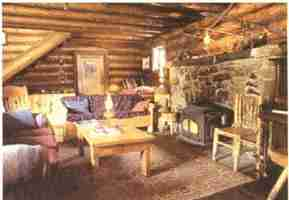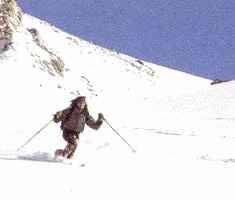Living Easy At Skoki Lodge
| This was luxury. We had cross country skied from our starting point at the Lake Louise Ski area, up and over two mountain passes that offered incredible views of the Canadian Rockies.The last few miles of our 8.9-mile ski had been downhill, but because it hadn't snowed for many days the pack was ice-glazed. Metal edge skis would have made the glide easier.When the broad wooden beams of the Skoki Lodge appeared through the trees, there was a quiet satisfaction in knowing the skiing phase of the journey was over. |
 Photo courtesy: Skoki Lodge |
 Photo: Lee Juillerat |
Usually, reaching a backcountry cabin means it's time for other chores: firing up a
sullen wood stove, melting snow for drinking and cooking water, and dethawing bodies and
clothes. But when I opened the lodge door my senses were juiced with the aroma of fresh
baked breads, cakes and cookies, homemade soup, hot tea and, best of all, the sight of a
large container of chilled fresh-from-the-creek drinking water. Welcome to Skoki Lodge. |
The Name: Skoki
How the name Skoki came into being is fuzzy. One version says a 1919 visitor from Chicago decided the area reminded him of Skokie, Illinois. Another says Skoki is an Indian word that means "marsh" or "swamp."
| However it was named, the Skoki area is beautiful. That's why in 1930 Earl Spencer was
hired to build Skoki Lodge. It's located at a literally breath-taking elevation of 7,100
feet alongside a creek in a valley bordered by spiring mountains and forests of Englemann
spruce, subalpine fir and whitebark pine. Huge spruce were used to create the lodge. Logs were cut from the nearby forest. Supplies were packed in on horses and, once, by a dog sled team. In 1931, a kitchen was added to the main cabin and two small cabins with bunk-style beds were built just a walk away. |
 Photo courtesy: Skoki Lodge |
The luster paled in 1933 when Dr. Christopher Paley, an MIT mathematician and member of the "Boston Ski Party," died in an avalanche. His and other deaths have become part of the region's ghostly lore.
Historically, the lodge has been the haunt of backcountry skiers and, more recently, summer hikers. Since the renewed interest in cross country skiing in the 1980s, Skoki Lodge has enjoyed a renaissance of interest. The lodge and its trio of nearby cabins sleep 22 guests. About 1,600 to 1,700 overnight visits are counted each winter, plus another 1,800 during the summer. Most visitors stay two nights or more. The summer season runs from about mid-June to late September while winter visits go daily from Christmas through New Year's Day, weekends until early February, and daily through mid-April, snow permitting.
A Rustic Lodge That Really Is
 Photo: Lee Juillerat |
Some places fight mightily to create a rustic image. Skoki Lodge doesn't have to. It's
the real thing. Its exterior is unchanged since 1936. Wooden skis and old-style snowshoes hang over the large stone fireplace. Huge beams and smoothed wooden floors glow with years of polishing. Fresh flowers bloom from vases while shelves offer a tempting array of books, and framed black and white photos recall days past. The cabins are large and spacious, but the rooms in the lodge are funky, spliced into nooks that fit a bed or two or three. |
Years ago the lodge had electricity, but when the system had problems it was abandoned. Now, pine cones fill otherwise empty light sockets. Kerosene lamps and candles provide light while winter chills are warmed by wood stoves and propane heaters. Men's and women's outhouses are a short stroll from the lodge. Another path leads to a wood-fired sauna.
 Photo courtesy: Skoki Lodge |
 Photo: Lee Juillerat |
A Region That Invites Discovery
Views during our ski in and out were obscured by clouds. At Deception Pass, an elevation of about 8,200 feet, we were nearly deceived by a ptarmigan whose pure white feathers melted in with the snow and clouds.
| The trail climbed mostly gently, passing the Halfway Hut (midway between the Lake
Louise train station, where trips to Skoki used to begin and end), over rock-strewn
Boulder Pass and along Ptarmigan Lake. The route is flanked by Redoubt and Fossil
mountains to the east and a series of peaks - Whitehorse, Richardson, Ptarmigan and the
Wall of Jericho to the west. It's a region that invites discovery, and encourages winter visitors to come again in summer. |
 Photo courtesy: Skoki Lodge |
And The Food
The food. In a word, yummers. Breakfast included a spicy omelet, fresh baked scones, juices and a table full of delectables. Another tray of breads, meats, fruits, cookies and goodies went into our bag lunches.
Even better was dinner. The lodge glowed with smells. We feasted on spring lamb, spanokopita, fresh baked bread, fusilli noodles, a vegetable medley, and Skoki salad. Dessert was raspberry pie.
The menu included plenty of roughage, but staying at Skoki Lodge was not roughing it.
| Lee Juillerat |
| Lee is regional editor of the Herald & News in Klamath Falls, Oregon. He is well-known for his adventurous newspaper photos and stories, and is the author of two books about Crater Lake National Park. |
Click here if you need details to plan your adventure to Skoki Lodge.